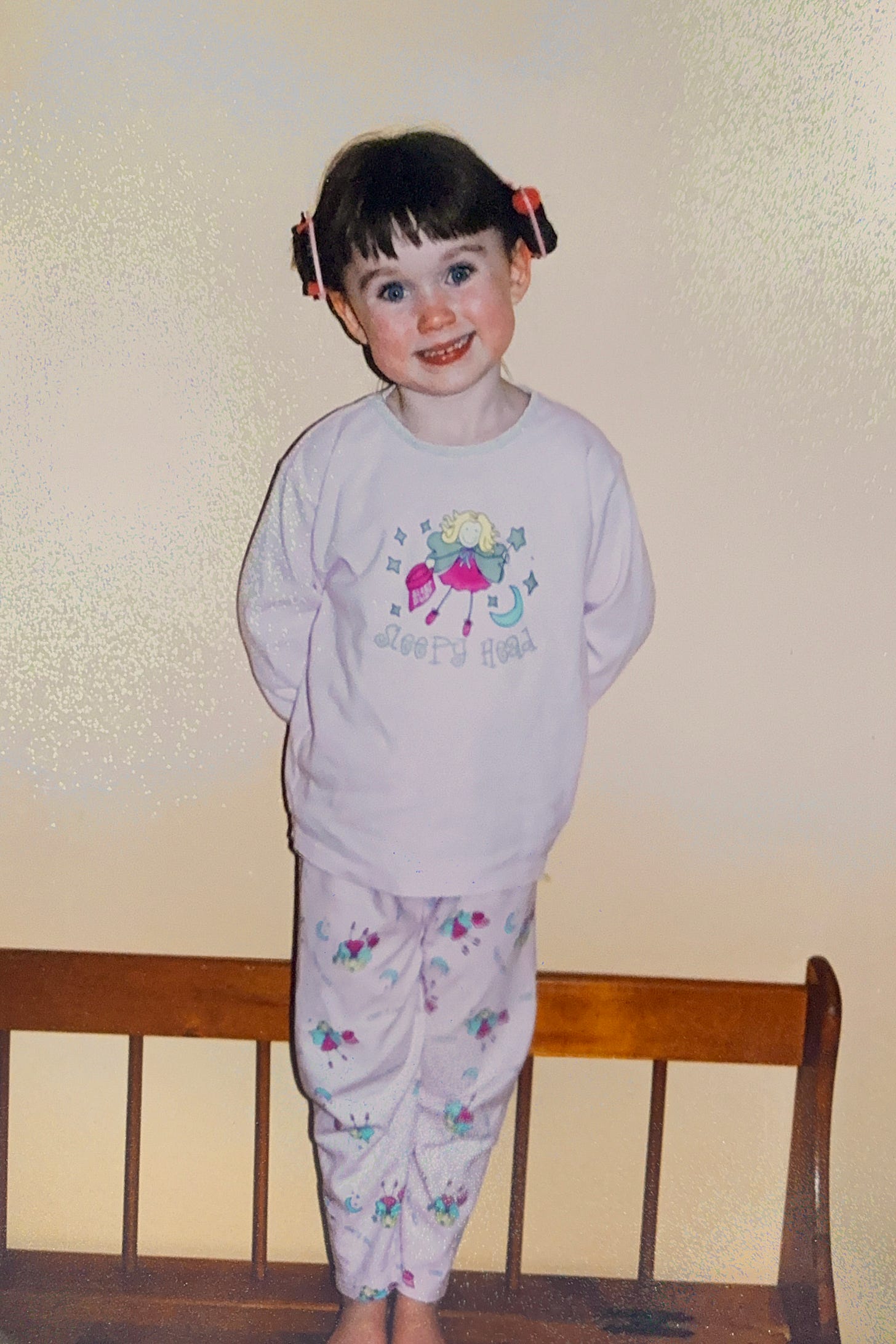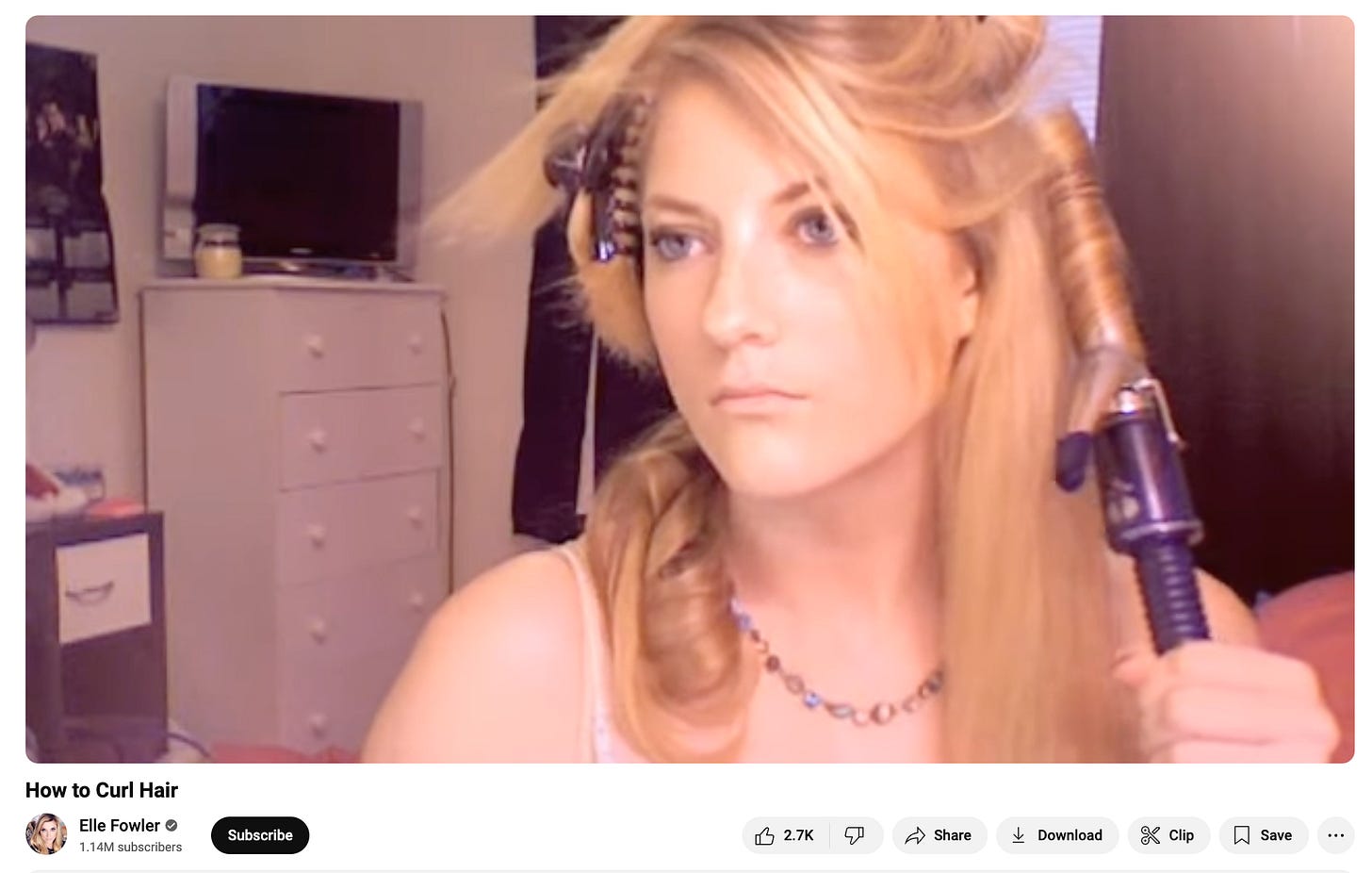On Youtube, Beauty, and Beauty Youtube
Reflections on Youtube beauty gurus and their impact on my tween girlhood.
My first internet safe space was beauty YouTube. The beauty gurus of 2009/10 welcomed me to their bubblegum-pink corner of the internet with open arms and my subscriptions listed Youtube handles made from the formula:
beauty product + feminine noun/adjective + number = username
(See: macbarbie07, stilababe09, Allthatglitters21…)
I remember coming home from primary school and immediately planting myself in front of the computer. For hours I’d watch teen girls spill out the contents of their handbags, tour their room, unveil new clothes, and show off collections of makeup so vast they could stock a shop (always with the disclaimer: “I’m not trying to brag in any way, shape, or form).
I watched video after video of drawers opening, each a new treasure chest. Colour-coordinated lipglosses, stacks of eyeshadow palettes, rows of Mac compacts that clicked and clacked as the guru flicked through them… it was the original ASMR. As I drunk in the glorious sights, I fantasised about organising my own collection even though the “makeup” I owned at this time consisted of several different flavours of Lip Smackers from Claire’s.
Growing up in Ireland, I didn’t have access to most of the brands favoured by beauty gurus— no Victoria’s Secret PINK body sprays or Bath and Body Works candles for me. There was no Ulta or Sephora to drive to where I could beg my parents to buy every shade of NYX Jumbo Eyeshadow Pencil. All I wanted was to amass my own trove of shimmers, glitters, glosses, and powders but they were always just out of reach (read: didn’t ship outside the U.S.). Looking back, I now think this was a good thing.
I was eleven when I first started watching makeup videos. I learned about different coverage foundations, how to blend eyeshadow into your crease, how to pick the perfect red lipstick, and the best products for each skin type. My skin was smooth and my cheeks were pudgy with baby fat. I hadn’t yet reached puberty as I took mental notes on skincare routines and acne coverage, storing them for future reference.
I accrued knowledge crucial to my feminine socialisation, internalising messages about “flattering” silhouettes, beauty standards, and overconsumption (seriously, I cannot emphasise enough how ridiculous those makeup collections were— we’re talking entire rooms dedicated to storing makeup). I had always been a girly-girl, my tiny hands reaching for plastic high heels and fake lipsticks in toy stores. But the social conditioning of babydoll gifts and pretend kitchens was left behind in early childhood. Now in tween girlhood, my gender construction was informed by classmates and Disney shows. However, one fateful day I stumbled onto Youtube and found an entire encyclopaedia on teen femininity. A digital manual with hours of footage instructing me on how to be a girl, the right way.
And I loved every second of it.
I grew up the youngest of three children with two older brothers whose interests were interchangeable with examples of “male stereotypes”: video games, sports, cars, sports cars, video games about sports cars. Like many boys growing up in the late nineties and early 2000s, they displayed a disdain for anything feminine. They mocked me for my Twilight poster as a tween, my 5 Seconds of Summer poster as a teen, and cultivated in me an internalised misogyny that would take a decade to undo. If they asked me what I was watching, I’d angle the screen away and lie, makeup tutorials branded as illicit material in my mind. I don’t blame them at all, this was a time when the internet was saturated with “still a better love story than Twilight” memes. Though they seemed so old and so wise through my childhood eyes, they were kids too.
I had exactly one (1) close female friend throughout primary school. She was also from a family of three children but hers was an all-girl household. My bff and Youtube beauty gurus were my main feminine education, for better or for worse.
There was something so comforting in the early Youtube beauty space before it got poisoned by the exposure of racists, sexual predators, drama, and endless product integrations. Social media influencers didn’t exist and we were all naïve to the potential power, money, and fame Youtube could foster. People were sitting down in their bedrooms in front of a webcam to talk about their favourite makeup and share tips with what felt like a small, intimate friend group. There was little to no editing, the quality was 480p on a good day, and people were creating for the sake of creating.
The beauty gurus I looked up to were just teenage girls. And yet, for a very brief period in time, they were the older sisters I never had. They passed down beauty advice, decor inspiration, and DIY tutorials, most of which I never used. But more importantly, they offered a safe space to indulge in all things hyper-feminine when femininity was so often the subject of ridicule and devaluation.
I look back on that time fondly. As the years passed I soured on beauty Youtube, not only because of the factors I mentioned above but because of a growing awareness of beauty trends and overconsumption. I understand that online makeup artists and beauty gurus review new makeup as a part of their job. Many of them have their own lines or collaborations and rely on that money as income.
However…
I know that, in my experience, watching makeup videos just makes me want to buy more. I already have more than enough makeup. I don’t need any more. I tell myself this often. And yet… if I see a video of “the dewiest cream blush”, “the glowiest highlighter”, or “the most pigmented eyeshadow” I feel itchy to buy stuff that I don’t need. Beauty Youtube has its roots in overconsumption (see again: absurdly huge makeup collections) and I fear it hasn’t moved past it.
And then there are the issues baked into the cosmetic industry and our notions of beauty. I, like many others, am exhausted with the expectation that women/femme-presenting people have to wear makeup to work, to school, to the shop, even in the comfort of our own homes. As well as that, the function of so many beauty tutorials is to make ourselves more attractive to the Eurocentric male gaze. The most “flattering” makeup often entails contouring a nose to make it smaller, covering up any acne or signs of ageing (aka “imperfections”), overlining lips to make them look fuller, using eye makeup to give the illusion of a “cat eye” or “fox eye”. This is not an issue unique to social media, it’s a fundamental facet of beauty standards and the beauty industry which capitalises off of our insecurities.
You don’t need me to tell you this information. I bring it up because it complicates what used to be such a simple pleasure of mine. I miss being able to enjoy beauty tutorials without a second thought, it’s become another childhood activity relegated to nostalgia. Gone are the times when I could watch a pretty teen girl put on shimmery eyeshadow without thinking about the crushing weight of beauty standards, gender socialisation, and the amount of time, money, and labour femme-presenting people lose every day in their quest to be “beautiful”.
As a Youtuber, my income relies on views and engagement. I know that the prettier I look in a thumbnail/video, the more likely people are to engage. Because of this, I find filming the most stressful part of the entire video process. Not only am I memorising a script as I record, I’m constantly worried about how I appear. I spend hours doing my hair and makeup, setting up lighting, and angling the camera so I look my best. Then I spend even more time staring at my face, going through frame-by-frame as I edit hours of footage down. I was once venting about this to a male Youtuber friend of mine and he said:
“Woah, that’s crazy. I filmed my last video after I went to the gym. I came home and filmed. I didn’t even shower or change.”
All I could do was sigh.
I’m grateful for the beauty gurus of my tweendom and for all the comfort they gave me. I’m also grateful I’ve moved past that point in my life, both able to enjoy makeup and analyse the concept of beauty with a critical eye. Beauty has long been the site of paradox and philosophy. My own reflections on Youtube, beauty, and beauty Youtube are a tiny step in the long legacy of discourse. But it’s a step nonetheless.







Your perspective is soooooo appreciated! This was such a special time in our youth and I feel like we knew it then, too. On one end, it created a capsule of creativity and individuality. As years went by, the caveat of the industry seemed to tip the scales into what we fully see today. I feel like we might dial it back a bit, but we shall see!
This inspired me to post about my own experiences with makeup from a teen obsessed with make-up to now being fearful of being perceived because of it. Excited for what you post next 💜